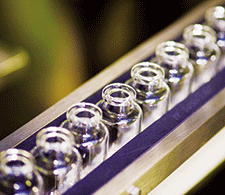Aseptic fill/finish is crucial in biopharma manufacturing and is optimized through automated technology.
By Feliza Mirasol

Aseptic filling is a crucial process in biopharmaceutical manufacturing because it has a potential safety impact on the end user and because aseptic filling is a highly technique-driven process. The stability of aseptically filled drugs will be affected by a variety of factors. Because aseptic filling requires close coordination and involves complex interaction between personnel, sterilized product, the fill/finish equipment system, the cleanroom—including support facilities and sterilized filling components, fill/finish processes are heavily dependent on technique, equipment, controls, and having detailed procedures (1).
Handling sterile liquids in the pharmaceutical industry has traditionally relied on consistent techniques over the past 100 years, and changes in technology and regulations have been relatively slow, which has resulted in only incremental improvements in safety, efficiency, and product quality. The rise of costly biologics over the past 20 years, however, has put greater pressure on downstream fill/finish operations to ensure that quality, safety, and cost efficiency are not compromised at the critical, late-stage fill/finish process, according to BioPlan Associates’ 14th Annual Report and Survey of Biopharmaceutical Manufacturing Capacity and Production (2).
The advancement of automation, including robotics, is one area of progress for fill/finish processes. Automation at this late-stage manufacturing step further reduces the risks of contamination, and most systems today, not including small manual operations, are typically highly automated. This has led to as few human interactions as possible at the fill/finish step, including the loading of raw materials, system changeovers, and cleaning (3).
Adopting automation
Typically, automated systems incorporate blow/fill/seal operations, dosing, environmental monitoring filling machines that use tool-less changeovers, in-process weight checks, self-adjusting fill volume controls, and single-use equipment/technology (4).
Fill/finish operations for biologics is largely automated as “the number of manual fill operations is diminishing,” says Iain MacGilp, PhD, head of manufacturing at the Glasgow facility of AMRI, a contract research and manufacturing organization. “While manual filling can be conducted ‘remotely’ in restricted access barrier systems (RABS) via manual filling, this is a small-volume operation with limited batch sizes (beyond clinical Phase I, the need for small batches becomes very limited).”
MacGilp notes that the automated filling process is well suited to biologics, as well as vaccines, gene therapies, oncolytic live virus-based therapies, monoclonal antibodies, and recombinant proteins. “There remains some perceived sensitivity to vaporized hydrogen peroxide (VHP) sanitization of contact surfaces and secondary surfaces as automated systems are generally contained within isolators/RABS employing VHP sanitization processes. AMRI Glasgow undertakes periodic VHP sanitization but retains aseptic assembly of contact surfaces, including bowls and chutes, among others, for stoppers/overseals. This was a conscious decision to provide broad offering for biologics and small molecules.”
ABL, a contract research, development, and biomanufacturing organization, is one example of a company that continues to adopt automation in fill/finish operations. In May 2017, the company completed an expansion of its aseptic fill/finish operations at its GMP biomanufacturing facility in Rockville, MD, where it installed a new, fully automated vial-filling system (5).
The company installed the new filling line to meet demand for innovative biologics, including vaccines, gene therapies, oncolytic live virus-based therapies, monoclonal antibodies, and recombinant proteins. The new line can accommodate lot sizes from 100 to 5000+ vials, with minimal product loss. ABL reported that the new system uses a disposable product-contact path to limit cross contamination and is contained in a RABS to increase sterility assurance level (SAL) and reduce the risk of random contamination by operator intervention (5).
Cost saving is another benefit of having automated processes. “In simplest form, the larger batch sizes available within the same processing duration provide costs of goods savings,” says MacGilp.
He notes that aseptic fill/finish facilities have high overheads, which include facility build/maintenance, power costs for water plants, oven/autoclaves/tunnels, and air handling systems. “Any higher throughput will, in turn, lower unit price. Automation within isolators allows the background to be held at Grade C, opposed to Grade B, which can reduce overhead contribution.”
In addition, there is a reduction in labor overheads with automated systems, however operators are still required to control and monitor processes, MacGilp points out. At a larger scale, automated inspection systems allow high throughput and lower the operator overheads.
“Clearly there is an associated investment in any technology, and servicing/maintenance requirements are higher. Any aseptic filling process should be conducted in shortest duration to minimize risk. Whether manual or automated, it is the throughput and reliability/reproducibility that supports cost benefits,” MacGilp says.
Fill/finish trends
According to BioPlan Associates, various trends have been identified in in-house (vs. outsourced) fill/finish operations for recombinant therapeutics, including industry capacity and capacity utilization. These current trends include the increased use of isolator/RAB technologies, more high-speed operations, more diversity in formulation and delivery systems, and other innovative approaches—such as one-step/combined blow/fill/seal operations (2). The firm also reports that in-house manufacturers typically have additional available fill/finish vialing, pre-filled device, and lyophilization capacity.
The introduction of isolator/RABS was shown to be the most important trend in 2017, followed by the trend of “facilities becoming more multi-product-use oriented”, the firm reports. Other important trends in fill/finish identified by BioPlan Associates include the adoption of single-use/disposable equipment, improved process lines/equipment, increased outsourcing to contract manufacturing organizations, further innovation for fill/finish equipment, a scale-down of isolator units and automation, potent compound handling, and more accurate filling for highly-potent biopharmaceuticals.
References
1. BioRealty, “Overview of Aseptic Fill/Finish Manufacturing,” www.biorealty.com/blog/overview-of-aseptic-fillfinish-manufacturing, accessed May 15, 2018.
2. BioPlan Associates, 14th Annual Report and Survey of Biopharmaceutical Manufacturing Capacity and Production (BioPlan Associates, Inc., Rockville, MD, April 2017).
3. E. Langer, Pharmaceutical Technology 40 (10) 2016.
4. R. Hernandez, BioPharm International 29 (9) 2016.
5. ABL, Inc., “ABL Increases Aseptic Fill/Finish Capacity with State-of-the-Art, Fully Automated Vial Filling Line,” Press Release, May 11, 2017.